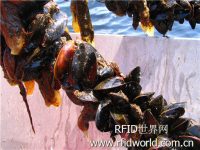
RFID tracks mussel farming in Spain
[ad_1]
Concepción Suárez Fernández is a home mussel breeder in Galicia, Spain. It is currently cooperating with the system engineering and automation department of Vigo University to test the ropes that use RFID to identify epiphyte mussels and track the cultivation of mussels.
“For a long time, this industry has lacked IT technology,” said Jorge Nuez, one of the principals of Concepción Suárez Fernández. “We need to know exactly the mussels in the cultivation bed and the cultivation time. We hope to predict the growth of the mussels in order to formulate sales plans.”
“We know that RFID technology is used in many industries. However, as far as we know, this industry has not yet used RFID,” Nuez said. “I think RFID can play an important role in rope identification.”
Vigo University took the lead in researching the feasibility of this technology, and designed pilot projects and wrote application software.
Mussels are cultivated on a floating breeding platform. Young mussels are planted on ropes and mature in the water until they are harvested. The size of the platform is about 500 square meters, and each rope weighs about 150-300 kg.

Using RFID to track mussel breeding ropes
“There are as many as 500 ropes on each platform. They are hung on different points and look the same in shape and size,” Nuez said. “We need a way to distinguish them. If you forget some ropes. They grow too large. Vegetables will fall into the sea. Some ropes will be lost in stormy weather.”
Now, RFID tags are attached to each rope, and the tags contain an ID code. The software tracks all relevant information about the mussels so that the company can know when the mussels are harvested. Nuez claims that RFID makes it easier to track mussels.
“There are several steps in this process,” Nuez said. “If a rope grows too many mussels, you have to divide it into two halves. When these ropes are put into the mussel bed again, we can trace the origin of these ropes, because the ropes of different breeding beds may be mixed together. In this way, We can learn about the source of mussels and how long they grow in the water.
The company uses Premo Group (HARSH-TAG-150), Confidex (Halo) and Intermec Technologies (Large Rigid Tag) tags. All tags comply with UHF and Gen2 standards. The label can withstand harsh mussel bed conditions. So far, the company uses Motorola MC9090-G handheld RFID reader to read all tags.
This RFID project is called SABT and is funded by the local government’s Galician research, development and technological innovation project.
According to Nuez, if the test into the tuxedo is successful, he hopes to use RFID in all four mussel beds operated by the company.
[ad_2]




